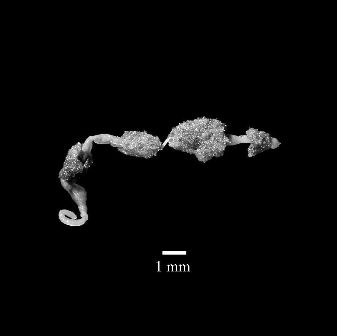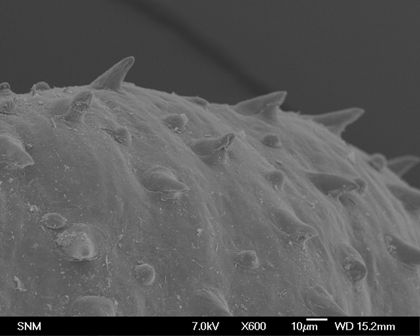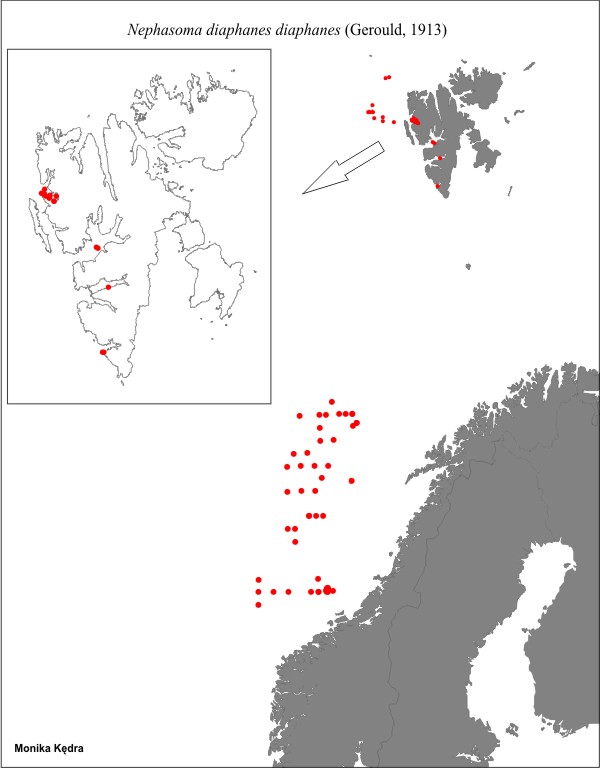Nephasoma diaphanes diaphanes (Gerould, 1913)
A cosmopolitan species - the most common sipunculan in deep-sea communities

Nephasoma diaphanes diaphanes in foraminiferan test |

Nephasoma diaphanes scattered_hooks |

|
Phascolosoma diaphanes Gerould, 1913
Golfingia diaphanes E. Cutler and Cutler, 1980
Distinguishing characteristics
Two retractors.
Transparent or translucent body wall.
Introvert shorter than the trunk with a few short tentacular lobes.
Scattered, spinelike hooks.
Immature specimens of other Nephasoma species might be (and very often are so the literature is full of unavoidable noise on this issue) easily mistaken with N. diaphanes.
Size
Common trunk length: 5 mm
Maximum trunk length: 55 mm
Color
Whitish, transparent or translucent body wall
Habitat
It inhabits sand, silt, clay and mud
Feeding
Deposit feeder
Life cycle
Dioecious, probably trochophore larva
More Biology & Ecology
It often lives in foraminiferan tests or small polychaete tubes. Larger shelter dwellers may have enlarged and darker posterior papillae. It is often the most common sipunculan in the deep water communities.
Distribution
Both sides of the northern Atlantic. Present from the wide range of bathymetric distribution; Very common in deep-sea communities.
References
- Cutler EB (1994) The Sipuncula. Their Systematics, Biology, and Evolution. 1-453
- Cutler EB, Cutler NJ (1986) Revision of the genus Nephasoma (Sipuncula:Golfingiidae). Proceedings of the Biological Society of Washington 99:547-573
- Gibbs PE (1982) The synonymy of the Golfingia species assigned to the abyssorum-section (Sipuncula). Sarsia 67:119-122
- Gibbs PE (2001) Sipunculans. Key and Notes for the Identification of British Species, Synopses of the British Fauna (New Series). Crothers J.H.// Hayward P.J.
- Gibbs PE, Cutler EB (1987) A classification of phylum Sipuncula. Bulletin of the British Museum Natural History Zoology 52:43-58
- Kędra M, Murina GV (2007) The sipunculan fauna of Svalbard. Polar Research 26:37-47
- Kędra M, Shields MA (2010) On the deep-sea Nephasoma species in the Eastern North Atlantic - A taxonomic guide, Marine Biology Research, DOI:10.1080/17451001003660293
- Murina GV, Sorensen J (2004) Marine Worms of the Phylum Sipuncula in Faroese waters. Frodskaparrit 51:280-291
- Pancucci-Papadopoulou MA, Murina GV, Zenetos A (1999) The phylum Sipuncula in the Mediteranean Sea. 1-109
- Saiz-Salinas JI (2007) Sipunculans and echiurans from the deep sea Angola Basin. Journal of Natural History 41:2789-2800
- Shields MA, Kędra M (2009) A deep burrowing sipunculan of ecological and geochemical importance. Deep-Sea Research I, 56, 2057-2064
